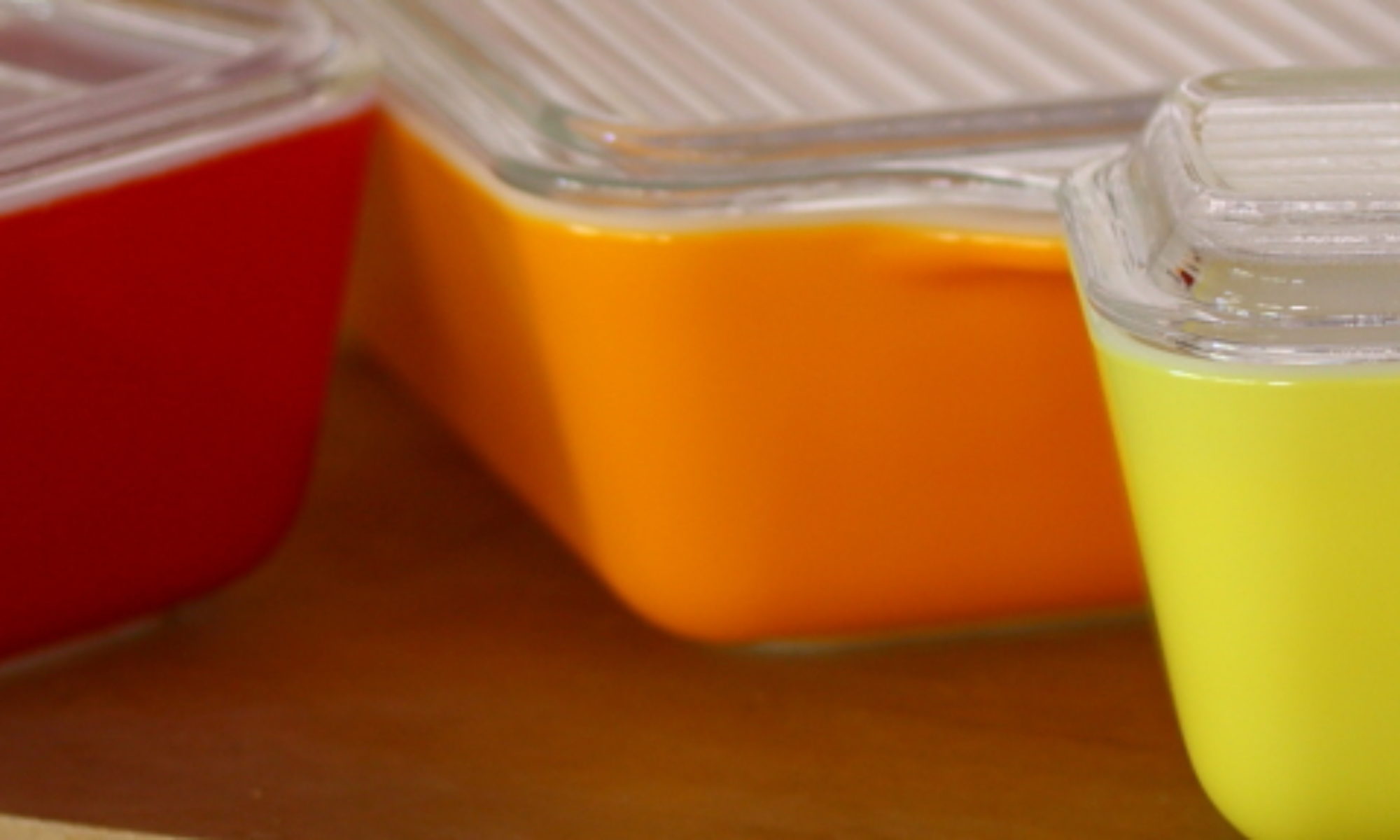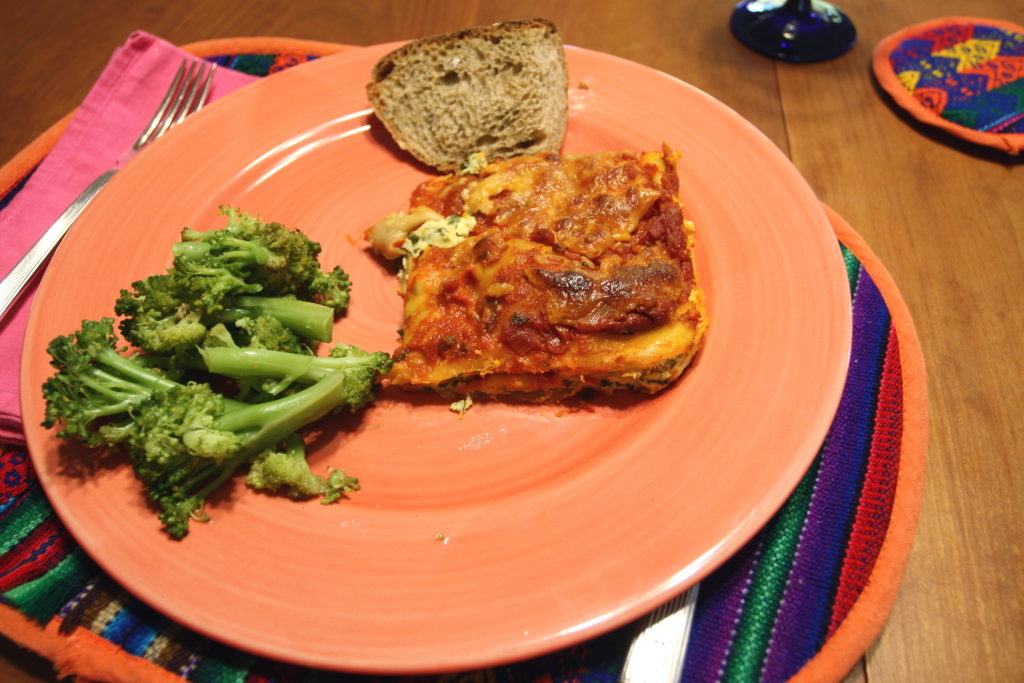
We’re in the process of putting together a dinner for about 25 people. Nothing super-fancy, but something nice, and, we hope, good. One thing that we really like to do when making food for others is to try it out in advance. That way, there won’t be any surprises (in this case, there was a small hitch, necessitating a change in schedule; more about that later).
For this dinner we decided on lasagna, well, two kinds of lasagna. The first is one we’ve made several times before and is super-good: Portobello Mushroom Lasagna. Today’s post concerns Eric’s Staff Lasagna, from The French Laundry Cookbook, by Thomas Keller. We figured that if it’s good enough for The French Laundry, it’ll probably be great for us.
While we followed much in the original recipe, we did make some changes. First, we used canned tomatoes — we can’t get great, or even good, fresh tomatoes, so we went with San Marzano tomatoes. Second, we used fresh pasta sheets, as they don’t need the pre-boiling step, making lasagna assembly a snap.
Staff Lasagna
Ingredients
- 1 batch basic pasta dough ready to roll (see note)
- 1/4 cup olive oil
- 3/4 cup minced white onions
- 1-2 cloves garlic minced
- 1/4 cup tomato paste
- 1 can San Marzano tomatoes (28 oz )
- 2 Tbs chopped fresh oregano
- Kosher salt
- Freshly ground black pepper
- 12 ounces whole-milk ricotta
- 2 eggs
- 1/4 cup flat-leaved parsley
- 1 cup 4 ounces grated mozzarella cheese
Instructions
- Heat oil in a large heavy-bottomed saucepan over medium heat. Add onions and garlic, and cook, stirring often, until tender and translucent, about 5 minutes. Add tomato paste and cook, stirring often, until oil is vividly orange, 10 minutes.
- Add tomatoes and break into chunks. Reduce heat to a simmer, and cook, stirring every 10 minutes or so, until sauce is thickened and reduced by about half, 1 1/2 to 2 hours.
- Remove from heat, stir in oregano. Taste and season with salt and pepper as needed. Let stand until cooled, about an hour.
- In a large bowl, whisk together ricotta cheese and eggs. Add parsley and stir to mix. Taste and season with salt and pepper.
- Preheat oven to 350°F.
- For assembly, roll pasta into very thin sheets as needed.
- Spread about 1 cup sauce on bottom of an 8x8-inch pan. Place a layer of pasta sheets over the sauce, covering it completely. Add a layer using half of the ricotta mixture, followed by another layer of pasta sheets. Spread sauce, reserving about 1 cup, over the pasta, then another layer of pasta, followed by the remaining ricotta mixture. Finish with a layer of pasta and the remaining tomato sauce.
- In a small bowl, toss the mozzarella cheese with a small amount of salt and pepper, then spread on top of the lasagna.
- Place in oven and bake, uncovered, until bubbly and browned in spots.
- Remove from oven and let stand about 15 minutes before serving.
Notes
Ingredient discussion:
We really recommend using fresh pasta. First, it tastes better. Second, you don’t have to pre-boil it, making the task of assembling lasagna easy. Imagine not having slippery, wet noodles, but thin, flexible pasta sheets that you can just put in place. We recommend using San Marzano tomatoes (or peeled fresh tomatoes if you can get them), simply because they’re better. And, don’t try to make a lower-calorie dish by using skimmed milk ricotta; if you’re watching calories, you might not want to be making lasagna in the first place.
Procedure in detail:
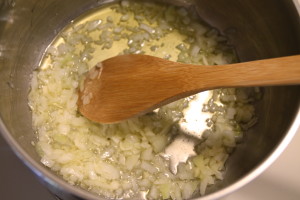
Cook onions and garlic. Heat oil in a large heavy-bottomed saucepan over medium heat. Heavy-bottomed is important, as you’ll be cooking this sauce a while and you don’t want it to burn. When the oil is hot, add the garlic and onions, and cook, stirring often, until they’re tender and translucent, about 5 minutes.
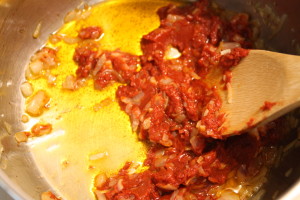
Cook paste. Stir in the tomato paste and cook, stirring nearly continuously to prevent sticking, until the paste separates and the oil is a vivid orange-red, about 10 minutes, total.
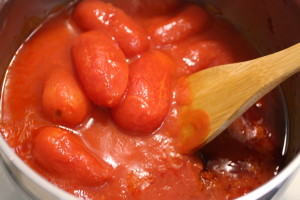
Simmer sauce. Add the tomatoes, use a wooden spoon to break them apart a bit, and bring to a simmer. Once simmering, reduce heat and continue to simmer, stirring every 10 minutes or so to prevent burning and sticking, until the sauce is thickened and reduced by about half. This should take 1 1/2 to 2 hours.
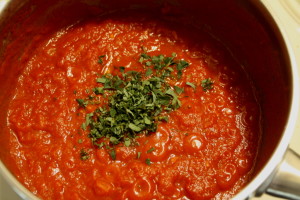
Season and let stand (maybe boil pasta). Remove the sauce from the heat and stir in the oregano. Give the sauce a taste, and add salt and pepper, as needed. Let the sauce cool to about room temperature before starting to assemble the lasagna. If you’re using commercial pasta that needs to be boiled, and now is the time to do so.
Preheat oven to 350°F.
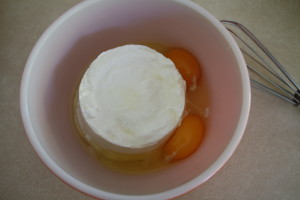
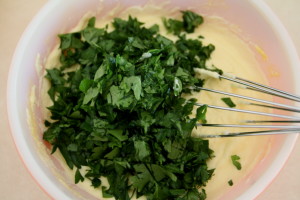
Whisk ricotta filling. Whisk together the eggs in a medium- sized bowl. At first it might not seem as though the two will whisk together — the cheese might seem tough — but they will, and the mixture will lighten up. Sprinkle the parsley on top and lightly whisk or stir in.
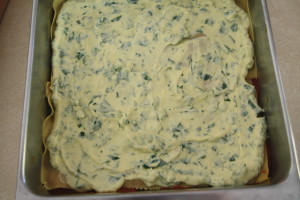
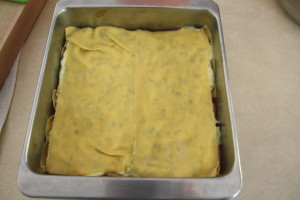
Layer lasagna. We’re making the assumption that you’re using fresh pasta, so you can roll out a sheet when you need it. That’s what we did and it’s easy. If you’re using pasta you have to boil, well, you did that three steps earlier. For the lasagna, you want two layers that are just cheese filling, with sauce on each side, so start by putting down about a cup of sauce and spreading on the bottom of the pan. Layer in pasta, overlapping as needed to cover the sauce. Scoop on half of the ricotta filling and spread it evenly over the pasta. Now another layer of pasta. For the next layer of sauce, use all but about a cup of sauce, followed by another layer of pasta and the remaining ricotta. Finish up with pasta and the remaining sauce. So you should have, from bottom to top: sauce, pasta, cheese, pasta, sauce, pasta, cheese, pasta, sauce. Good.
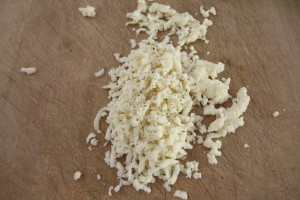
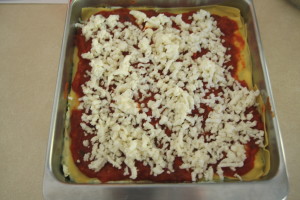
Season mozzarella. In a small bowl, or, if you want to cook more like we do, on the cutting board, toss the mozzarella cheese with some salt and pepper. We used about 1/4 teaspoon of pepper, and about 1/2 teaspoon of salt. The original recipe stated that this adds some flavor to the mozzarella, and, since it only takes a few seconds, it’s a no-brainer. Once seasoned, sprinkle the cheese on top of the lasagna.
Bake. Into the oven, uncovered, and bake until bubbly and browned, about 45 to 60 minutes.
Stand. Lasagna is always better if it’s had the chance to stand for 15 minutes or so before serving. We think this is true for two reasons: one, hot cheeses taste as if they’ve lost some of their flavor, so you get some flavor back as they cool, and, two, if you burn your mouth on the first bite, the meal loses some of its appeal.
As with nearly every recipe we tried that has Thomas Keller’s name on it, this rates five stars. It’s not anymore difficult than other lasagnas, and, in many respects, it’s really very similar, with the main difference being the length of time that the sauce simmers. Spending the time to cook down the sauce helps to increase the tomato flavor, and brings out a lot of nuanced flavors. The most obvious thing we noticed was that the bitterness in the tomato sauce decreased as we simmered it. Often that bitterness is masked with the addition of lots of salt, but, with the prolonged simmering, less salt is needed. But, we also noticed that the long simmer concentrated the tomato flavor, making for a more tomato-y tasting lasagna.
